Input Impedance Analysis of Wearable Antenna and Experimental Study with Real Human Subjects: Differences between Individual Users
Abstract
1. Introduction
2. Proposed Human Body Communication System
3. Models for Electromagnetic Field Simulation
4. Analytical Results Using the Realistic Arm Model
5. Measurement System and Real Human Subjects
6. Measurement Results
7. Influence of Tissue Structure
7.1. Development of the Simplified Arm Model
7.2. Measured Impedance Compared with Calculated Impedance for Various Thicknesses of Skin and Fat Layers
8. Conclusions
Author Contributions
Funding
Institutional Review Board Statement
Informed Consent Statement
Data Availability Statement
Conflicts of Interest
References
- Weiser, M. The Computer for the 21st Century. Sci. Am. 1991. [Google Scholar] [CrossRef]
- CES. 2021. Available online: https://www.ces.tech/ (accessed on 4 May 2021).
- Lara, O.D.; Labrador, M.A. A Survey on Human Activity Recognition Using Wearable Sensors. IEEE Commun. Surv. Tutor. 2013, 15, 1192–1209. [Google Scholar] [CrossRef]
- Pernek, I.; Kurillo, G.; Stiglic, G.; Bajcsy, R. Recognizing the Intensity of Strength Training Exercises with Wearable Sensors. J. Biomed. Inform. 2015, 58, 145–155. [Google Scholar] [CrossRef]
- Yin, J.; Yang, Q.; Pan, J.J. Sensor-Based Abnormal Human-Activity Detection. IEEE Trans. Knowl. Data Eng. 2008, 20, 1082–1090. [Google Scholar] [CrossRef]
- Pantelopoulos, A.; Bourbakis, N.G. A Survey on Wearable Sensor-Based Systems for Health Monitoring and Prognosis. IEEE Trans. Syst. Man Cybern. C 2010, 40, 1–12. [Google Scholar] [CrossRef]
- Asada, H.H.; Shaltis, P.; Reisner, A.; Rhee, S.; Hutchinson, R.C. Mobile Monitoring with Wearable Photoplethysmographic Biosensors. IEEE Eng. Med. Biol. Mag. 2003, 22, 28–40. [Google Scholar] [CrossRef] [PubMed]
- Takamatsu, R.; Higuchi, K.; Muramatsu, D. Measurement Frequency Evaluation for Bioimpedance-Based Blood-Glucose Estimation. In Proceedings of the 2021 IEEE 3rd Global Conference on Life Sciences and Technologies (LifeTech), Nara, Japan, 9–11 March 2021; pp. 309–310. [Google Scholar]
- Ali, H.; Bensaali, F.; Jaber, F. Novel Approach to Non-Invasive Blood Glucose Monitoring Based on Transmittance and Refraction of Visible Laser Light. IEEE Access 2017, 5, 9163–9174. [Google Scholar] [CrossRef]
- Jin, H.; Abu-Raya, Y.S.; Haick, H. Advanced Materials for Health Monitoring with Skin-Based Wearable Devices. Adv. Healthc. Mater. 2017, 6, 1700024. [Google Scholar] [CrossRef]
- Cao, H.; Leung, V.; Chow, C.; Chan, H. Enabling Technologies for Wireless Body Area Networks: A Survey and Outlook. IEEE Commun. Mag. 2009, 47, 84–93. [Google Scholar] [CrossRef]
- Movassaghi, S.; Abolhasan, M.; Lipman, J.; Smith, D.; Jamalipour, A. Wireless Body Area Networks: A Survey. IEEE Commun. Surv. Tutor. 2014, 16, 1658–1686. [Google Scholar] [CrossRef]
- IEEE Standard for Local and Metropolitan Area Networks—Part 15.6: Wireless Body Area Networks; IEEE Std 802.15.6-2012; Institute of Electrical and Electronics Engineers: New York, NY, USA, 2012; pp. 1–271. [CrossRef]
- Zimmerman, T.G. Personal Area Networks: Near-Field Intrabody Communication. IBM Syst. J. 1996, 35, 609–617. [Google Scholar] [CrossRef]
- Salonen, P.; Rahmat-Samli, Y. Effects of Antenna Bending on Input Matching and Impedance Bandwidth. IEEE Aerosp. Electron. Syst. Mag. 2007, 22, 18–22. [Google Scholar] [CrossRef]
- Mahmud, S.; Dey, S.; Saha, N. Super Wide Band Wearable Antenna: Assessment of the Conformal Characteristics in Terms of Impedance Matching and Radiation Properties. In Proceedings of the 2012 International Symposium on Antennas and Propagation (ISAP), Nagoya, Japan, 29 October 2012; pp. 563–566. [Google Scholar]
- Jeong, J.; Park, K.; Lee, C. Design of Cavity-Backed Bow-Tie Antenna with Matching Layer for Human Body Application. Sensors 2019, 19, 4015. [Google Scholar] [CrossRef] [PubMed]
- Dissanayake, T.; Esselle, K.P.; Yuce, M.R. Dielectric Loaded Impedance Matching for Wideband Implanted Antennas. IEEE Trans. Microw. Theory Tech. 2009, 57, 2480–2487. [Google Scholar] [CrossRef]
- Kim, I.; Lee, S.-G.; Nam, Y.-H.; Lee, J.-H. Investigation on Wireless Link for Medical Telemetry Including Impedance Matching of Implanted Antennas. Sensors 2021, 21, 1431. [Google Scholar] [CrossRef] [PubMed]
- Bae, J.; Song, K.; Lee, H.; Cho, H.; Yoo, H.-J. A 0.24-NJ/b Wireless Body-Area-Network Transceiver With Scalable Double-FSK Modulation. IEEE J. Solid State Circuits 2012, 47, 310–322. [Google Scholar] [CrossRef]
- Mao, J.; Yang, H.; Lian, Y.; Zhao, B. A Self-Adaptive Capacitive Compensation Technique for Body Channel Communication. IEEE Trans. Biomed. Circuits Syst. 2017, 11, 1001–1012. [Google Scholar] [CrossRef]
- Wang, H.; Tang, X.; Choy, C.S.; Leung, K.N.; Pun, K.P. A 5.4-MW 180-Cm Transmission Distance 2.5-Mb/s Advanced Techniques-Based Novel Intrabody Communication Receiver Analog Front End. IEEE Trans. VLSI Syst. 2015, 23, 2829–2841. [Google Scholar] [CrossRef]
- Wang, H.; Tang, X.; Choy, C.S.; Sobelman, G.E. Cascaded Network Body Channel Model for Intrabody Communication. IEEE J. Biomed. Health Inform. 2016, 20, 1044–1052. [Google Scholar] [CrossRef]
- Kazim, M.I.; Kazim, M.I.; Wikner, J.J. Complex Path Impedance Estimation and Matching Requirements for Body-Coupled Communication. In Proceedings of the 2015 European Conference on Circuit Theory and Design (ECCTD), Trondheim, Norway, 24 August 2015; pp. 1–4. [Google Scholar]
- Nishida, Y.; Sasaki, K.; Yamamoto, K.; Muramatsu, D.; Koshiji, F. Equivalent Circuit Model Viewed From Receiver Side in Human Body Communication. IEEE Trans. Biomed. Circuits Syst. 2019, 13, 746–755. [Google Scholar] [CrossRef] [PubMed]
- Muramatsu, D.; Koshiji, F.; Koshiji, K.; Sasaki, K. Input Impedance Analysis of a Human Body Communication Transmitter Using a Realistic Human Model and a Simplified Layered Model. Trans. Jpn. Inst. Electron. Packag. 2013, 16, 528–534. [Google Scholar] [CrossRef]
- Muramatsu, D.; Koshiji, F.; Koshiji, K.; Sasaki, K. Analytical and Experimental Studies on Human Body Communication between Wristwatch and Handheld Devices Using Muscle Homogenous Phantom at 10 MHz. Sens. Mater. 2014, 26, 9. [Google Scholar]
- Fujii, K.; Takahashi, M.; Ito, K. Electric Field Distributions of Wearable Devices Using the Human Body as a Transmission Channel. IEEE Trans. Antennas Propagat. 2007, 55, 2080–2087. [Google Scholar] [CrossRef]
- Haga, N.; Saito, K.; Takahashi, M.; Ito, K. Equivalent Circuit of Intrabody Communication Channels Inducing Conduction Currents Inside the Human Body. IEEE Trans. Antennas Propagat. 2013, 61, 2807–2816. [Google Scholar] [CrossRef]
- Yamamoto, K.; Nishida, Y.; Sasaki, K.; Muramatsu, D.; Koshiji, F. Electromagnetic Field Analysis of Signal Transmission Path and Electrode Contact Conditions in Human Body Communication. Appl. Sci. 2018, 8, 1539. [Google Scholar] [CrossRef]
- Maity, S.; He, M.; Nath, M.; Das, D.; Chatterjee, B.; Sen, S. Bio-Physical Modeling, Characterization, and Optimization of Electro-Quasistatic Human Body Communication. IEEE Trans. Biomed. Eng. 2019, 66, 1791–1802. [Google Scholar] [CrossRef]
- Muramatsu, D.; Koshiji, F.; Koshiji, K.; Sasaki, K. Input Impedance Analysis of Wearable Antenna and Its Experimental Study with Real Human Body. In Proceedings of the 2014 IEEE International Conference on Consumer Electronics (ICCE), Las Vegas, NV, USA, 10 January 2014; pp. 151–152. [Google Scholar]
- Hachisuka, K.; Nakata, A.; Takeda, T.; Shiba, K.; Sasaki, K.; Hosaka, H.; Itao, K. Development of Wearable Intra-Body Communication Devices. Sens. Actuators A Phys. 2003, 105, 109–115. [Google Scholar] [CrossRef]
- International Telecommunication Union. Available online: http://www.itu.int/en/pages/default.aspx (accessed on 4 May 2021).
- International Standard ISO/IEC 17982 Information Technology—Telecommunications and Information Exchange between Systems—Close Capacitive Coupling Communication Physical Layer (CCCC PHY); Technical Committee—ISO/IEC JTC 1/SC 6 Telecommunications and Information Exchange Between Systems: Geneva, Switzerland, 2012; pp. 1–48.
- Nagaoka, T.; Watanabe, S.; Sakurai, K.; Kunieda, E.; Watanabe, S.; Taki, M.; Yamanaka, Y. Development of Realistic High-Resolution Whole-Body Voxel Models of Japanese Adult Males and Females of Average Height and Weight, and Application of Models to Radio-Frequency Electromagnetic-FIeld Dosimetry. Phys. Med. Biol. 2004, 49, 1–15. [Google Scholar] [CrossRef] [PubMed]
- Gabriel, S.; Lau, R.W.; Gabriel, C. The Dielectric Properties of Biological Tissues: II. Measurements in the Frequency Range 10 Hz to 20 GHz. Phys. Med. Biol. 1996, 41, 2251–2269. [Google Scholar] [CrossRef] [PubMed]
- Nakano, H.; Ikeda, N.; Wu, Y.-Y.; Suzuki, R.; Mimaki, H.; Yamauchi, J. Realization of Dual-Frequency and Wide-Band VSWR Performances Using Normal-Model Helical and Inverted-F Antennas. IEEE Trans. Antennas Propagat. 1998, 46, 788–793. [Google Scholar] [CrossRef]
- Southwood, W.F.W. The Thickness of the Skin. Plast. Reconstr. Surg. 1955, 15, 423–429. [Google Scholar] [CrossRef] [PubMed]
- Gordon, R.G.; Roemer, R.B.; Horvath, S.M. A Mathematical Model of the Human Temperature Regulatory System—Transient Cold Exposure Response. IEEE Trans. Biomed. Eng. 1976, BME-23, 434–444. [Google Scholar] [CrossRef] [PubMed]
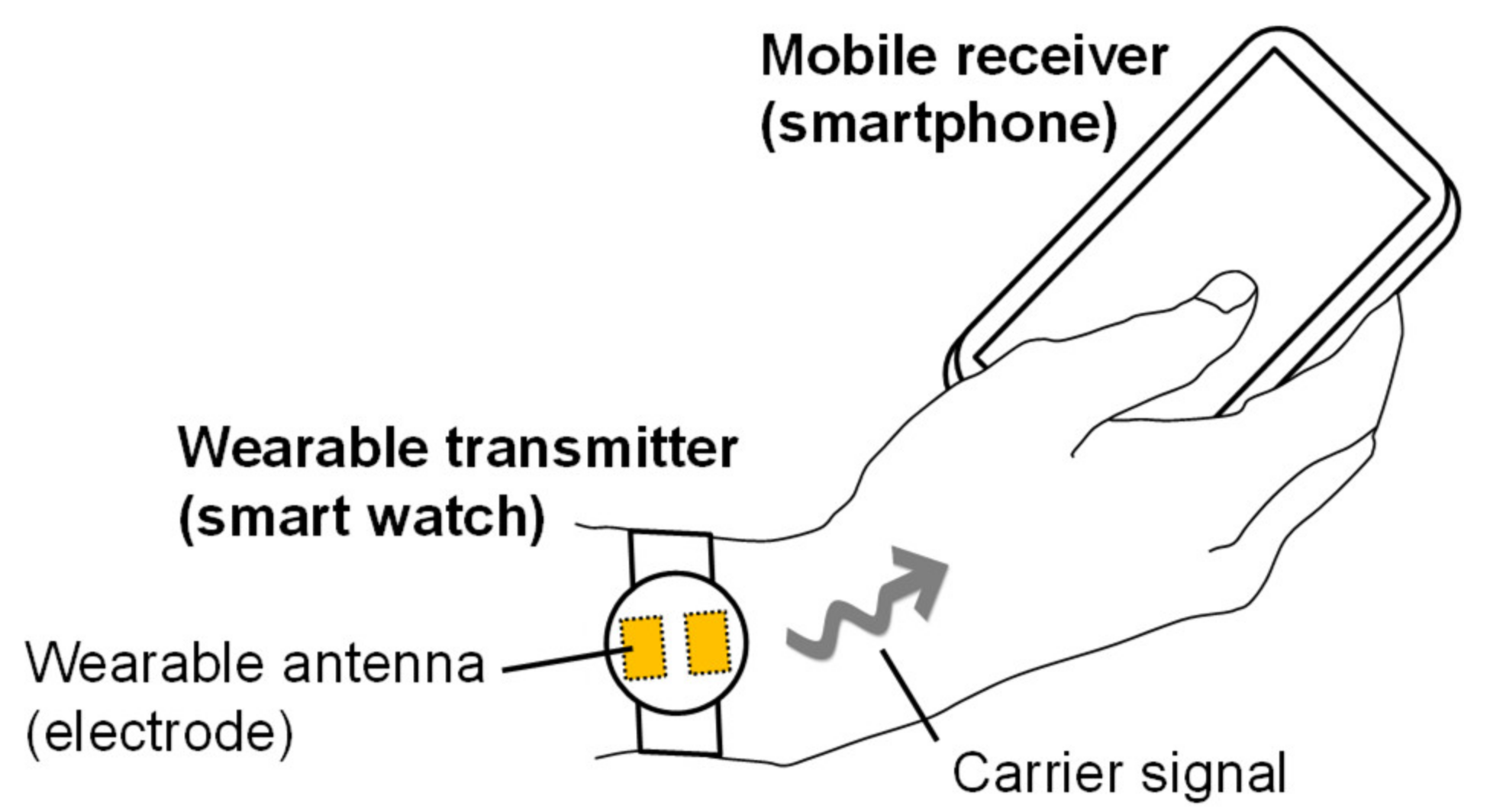
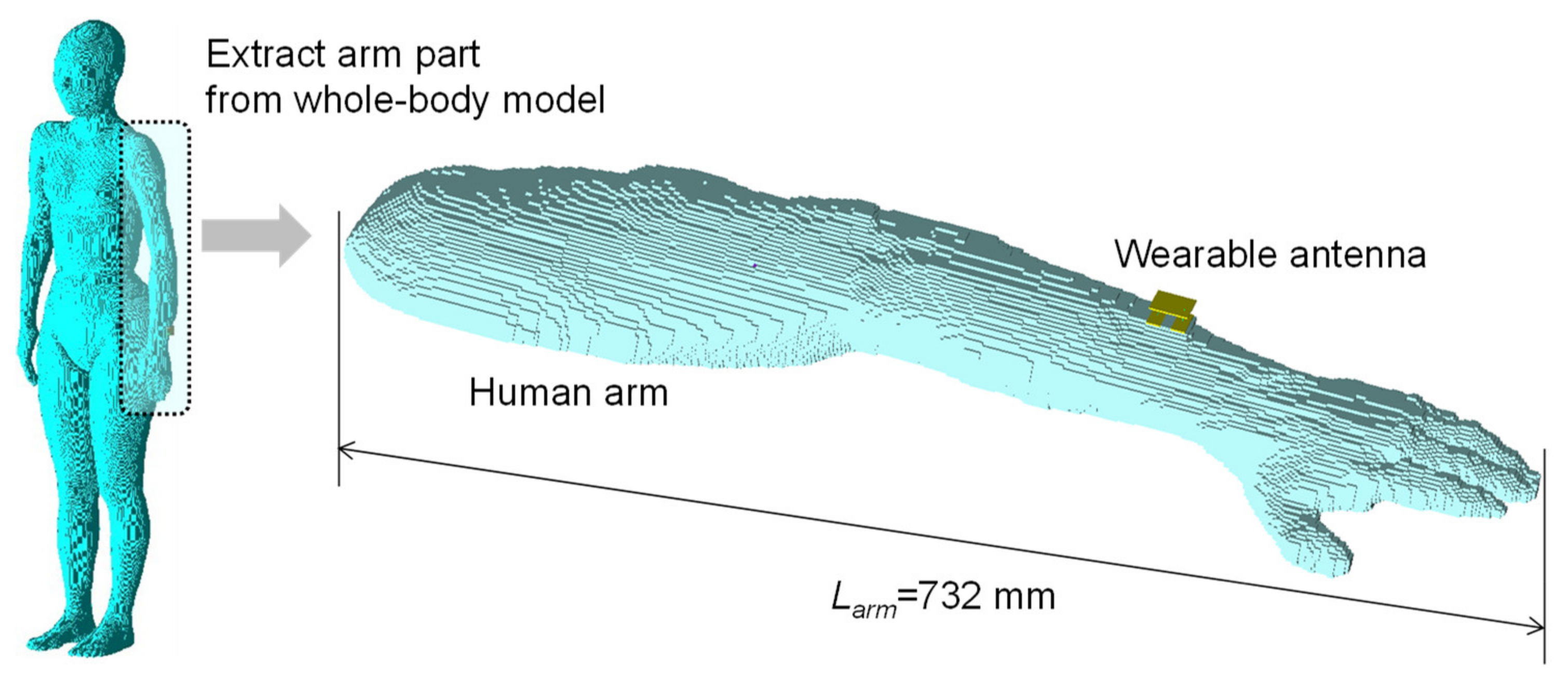
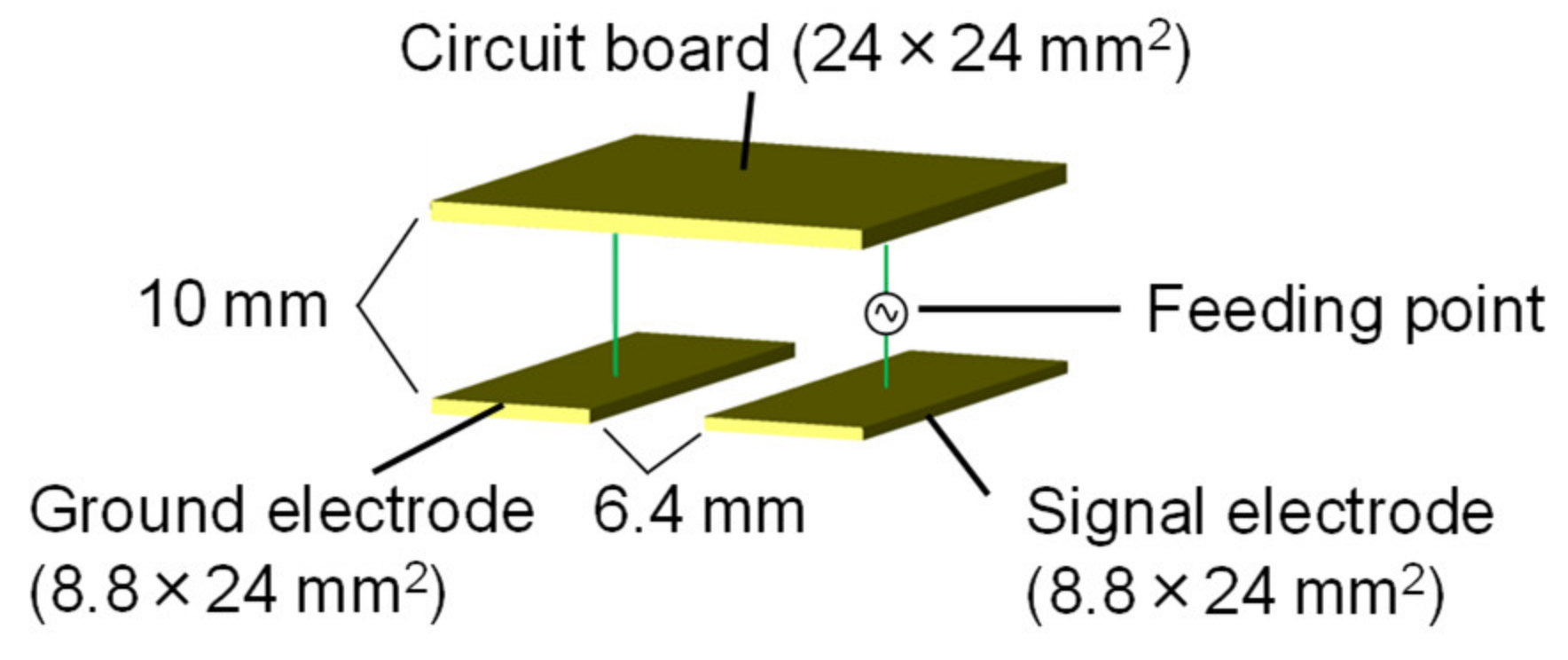

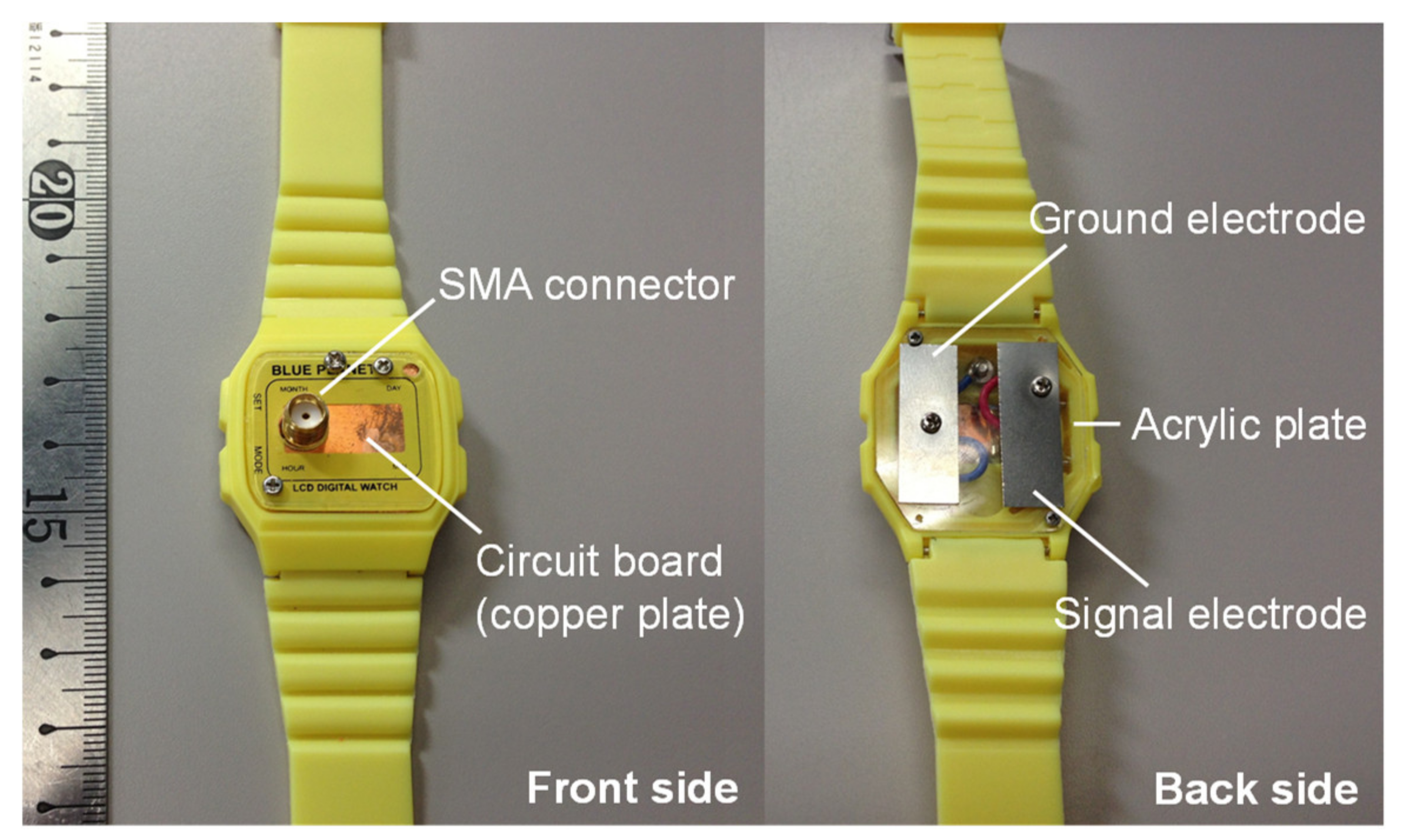
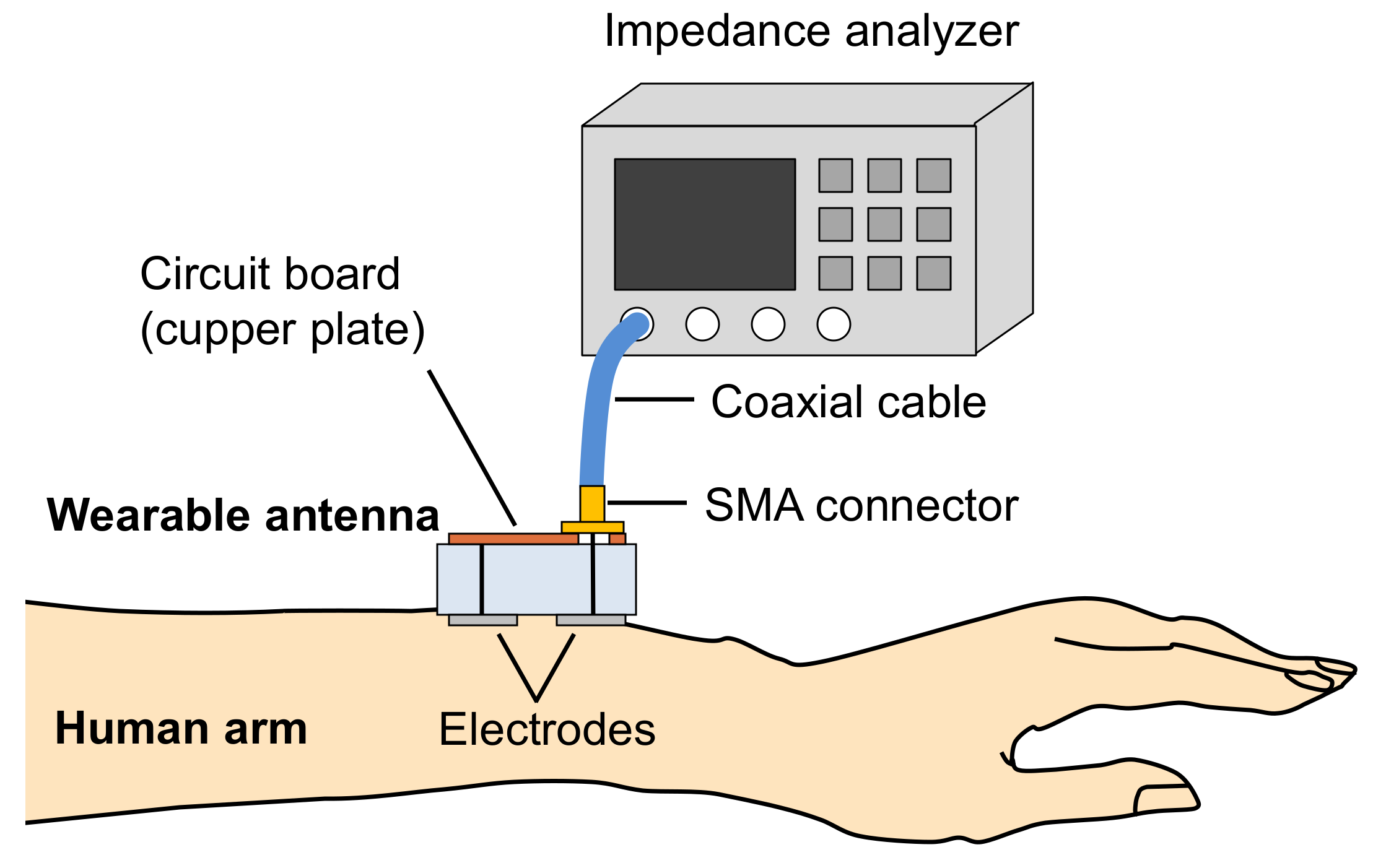
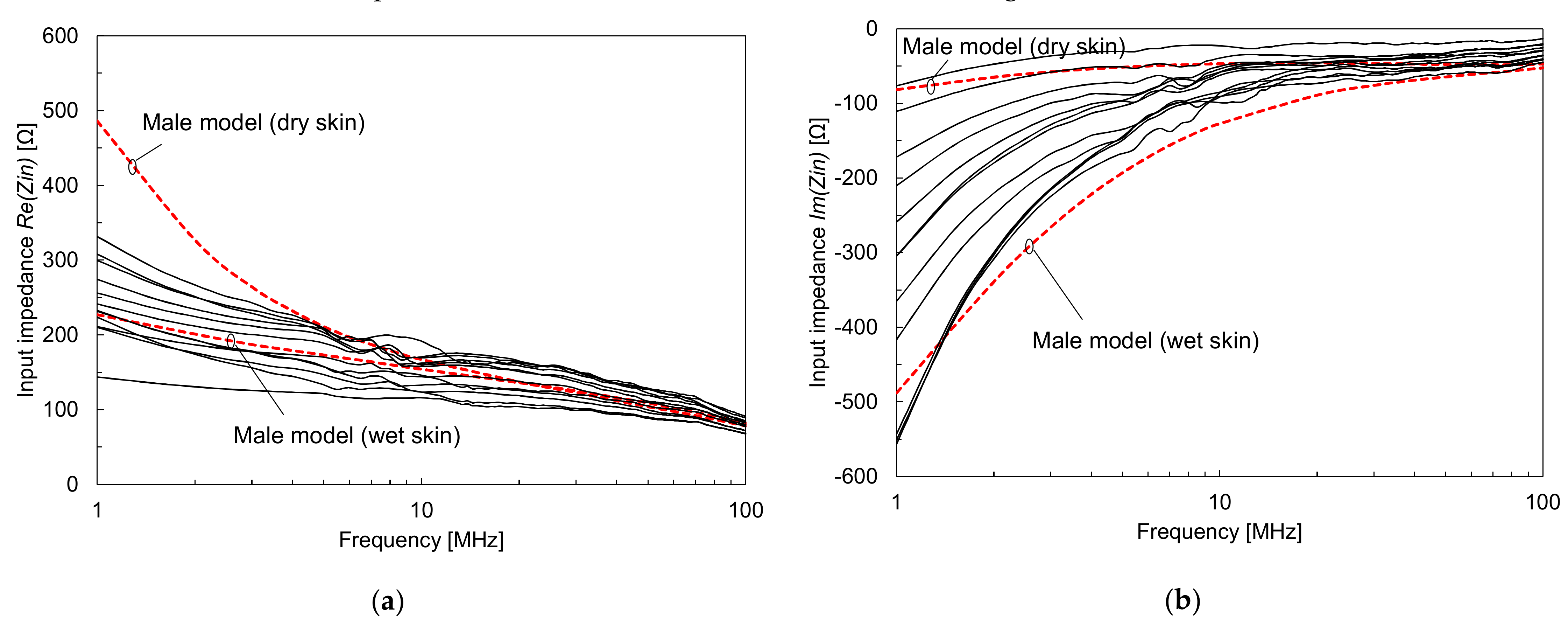
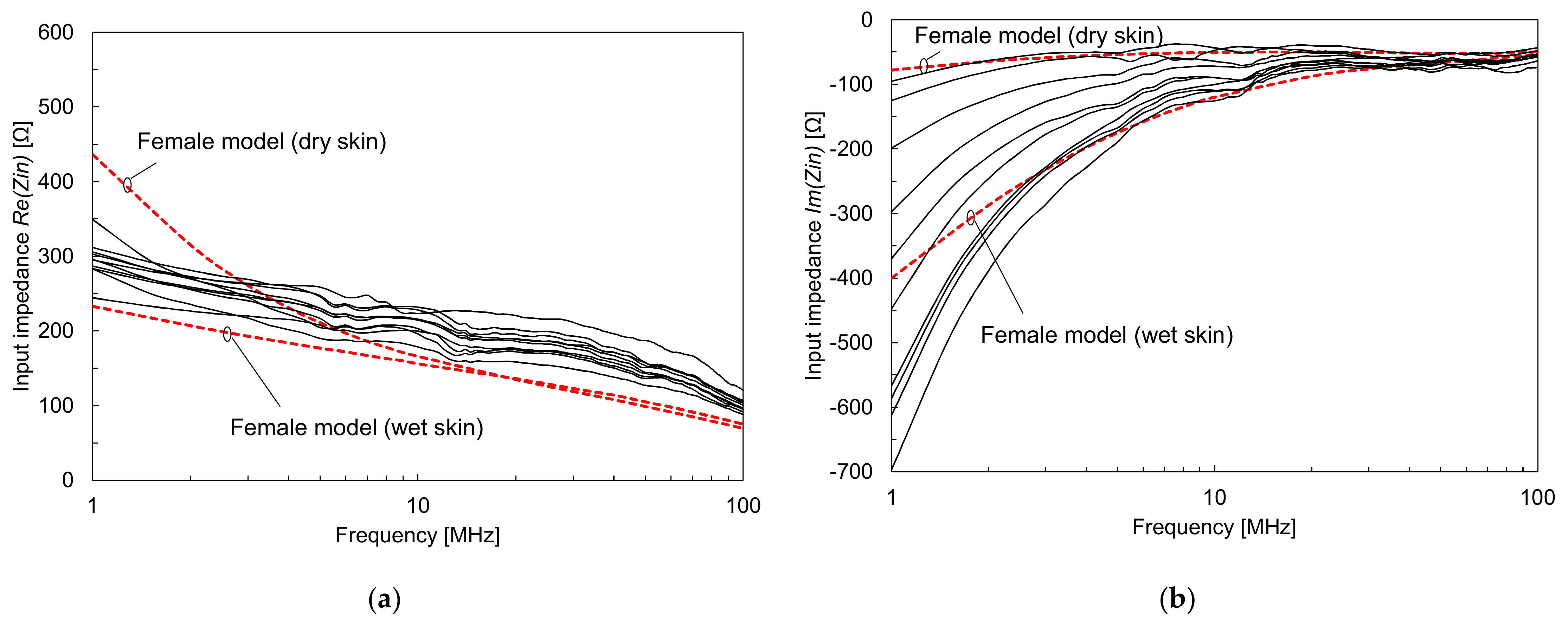

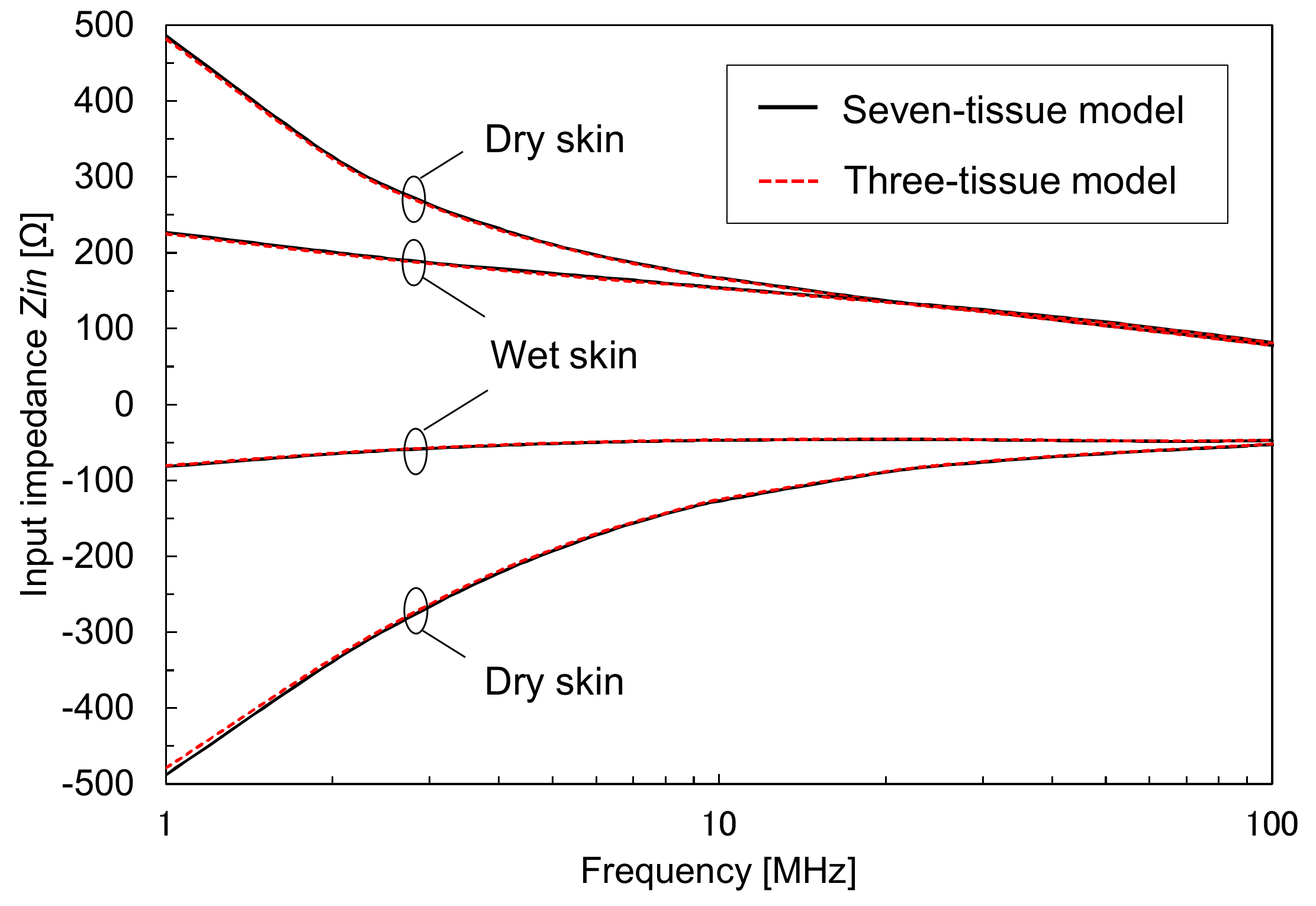
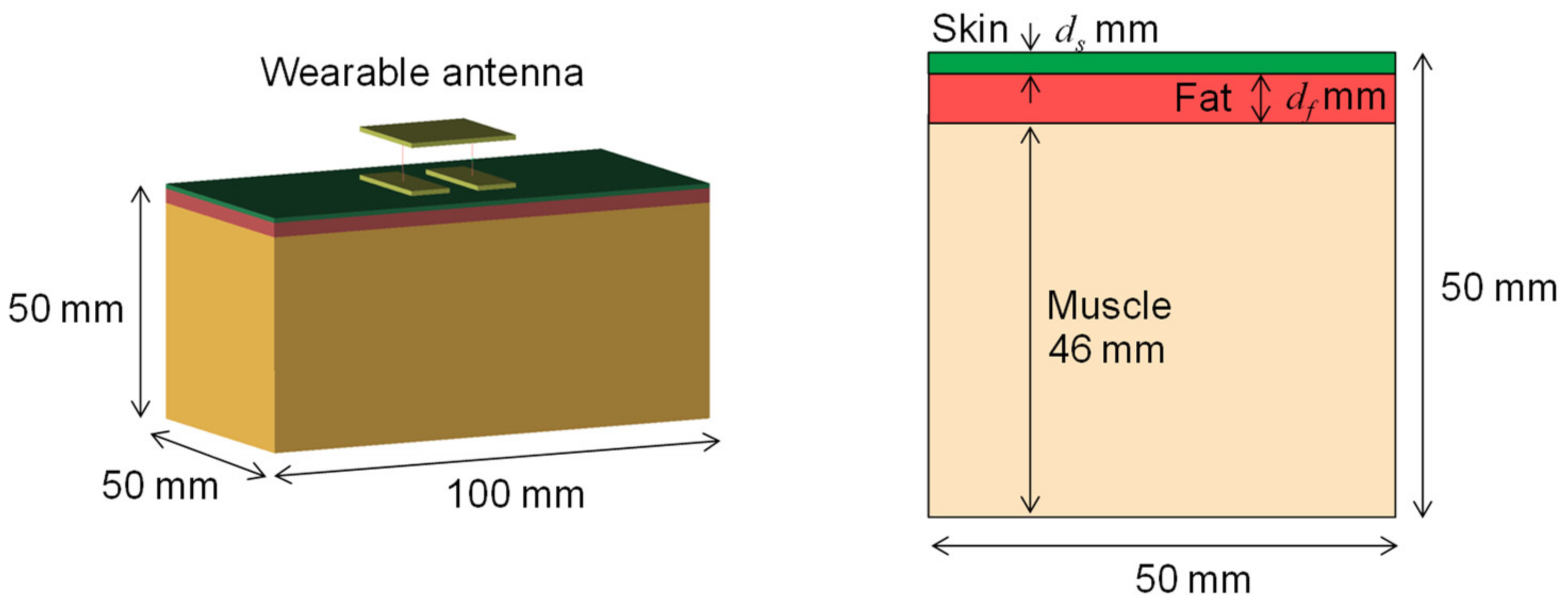
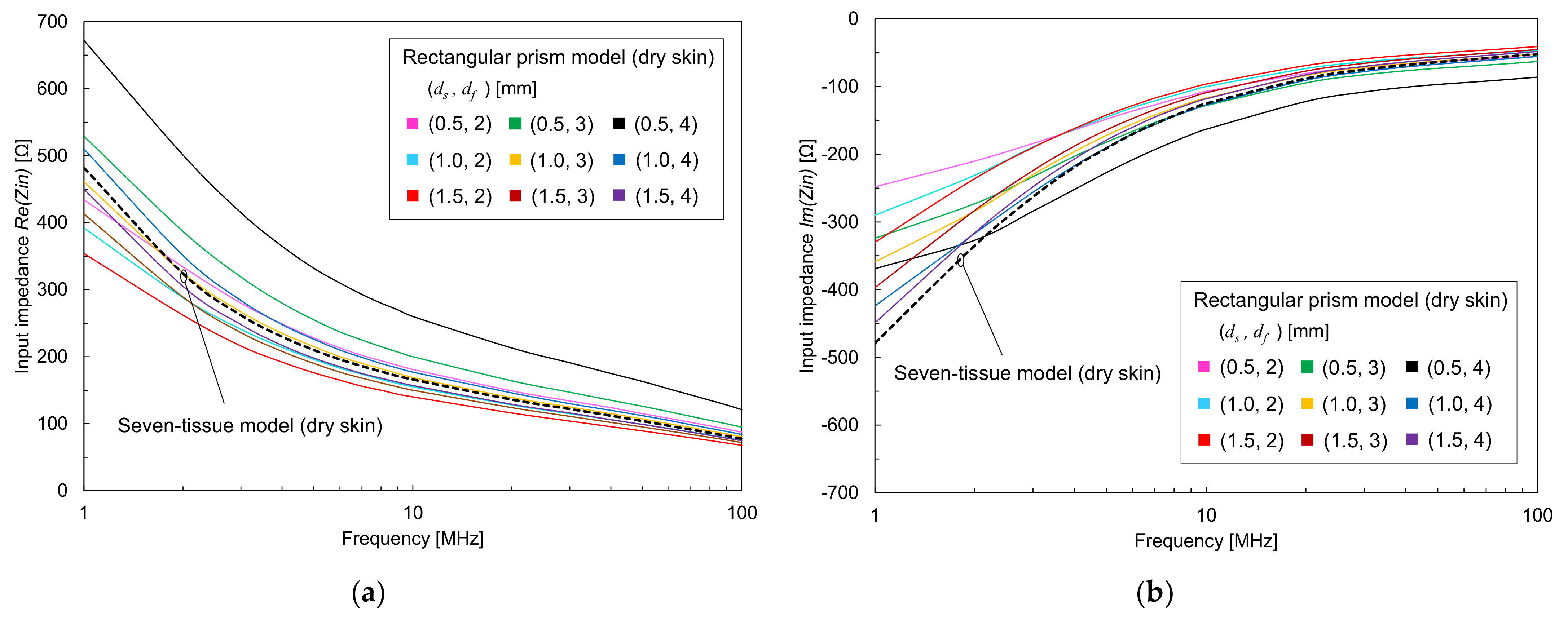

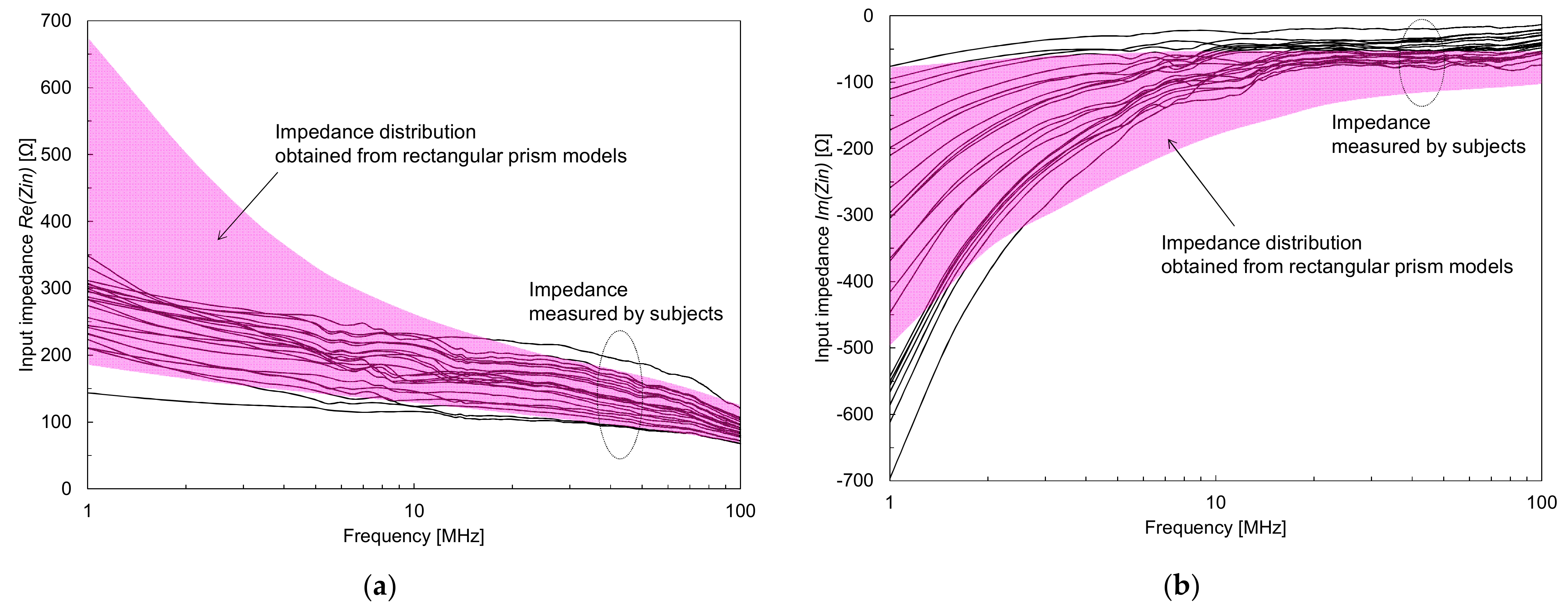
Publisher’s Note: MDPI stays neutral with regard to jurisdictional claims in published maps and institutional affiliations. |
© 2021 by the authors. Licensee MDPI, Basel, Switzerland. This article is an open access article distributed under the terms and conditions of the Creative Commons Attribution (CC BY) license (https://creativecommons.org/licenses/by/4.0/).
Share and Cite
Muramatsu, D.; Sasaki, K. Input Impedance Analysis of Wearable Antenna and Experimental Study with Real Human Subjects: Differences between Individual Users. Electronics 2021, 10, 1152. https://doi.org/10.3390/electronics10101152
Muramatsu D, Sasaki K. Input Impedance Analysis of Wearable Antenna and Experimental Study with Real Human Subjects: Differences between Individual Users. Electronics. 2021; 10(10):1152. https://doi.org/10.3390/electronics10101152
Chicago/Turabian StyleMuramatsu, Dairoku, and Ken Sasaki. 2021. "Input Impedance Analysis of Wearable Antenna and Experimental Study with Real Human Subjects: Differences between Individual Users" Electronics 10, no. 10: 1152. https://doi.org/10.3390/electronics10101152
APA StyleMuramatsu, D., & Sasaki, K. (2021). Input Impedance Analysis of Wearable Antenna and Experimental Study with Real Human Subjects: Differences between Individual Users. Electronics, 10(10), 1152. https://doi.org/10.3390/electronics10101152






